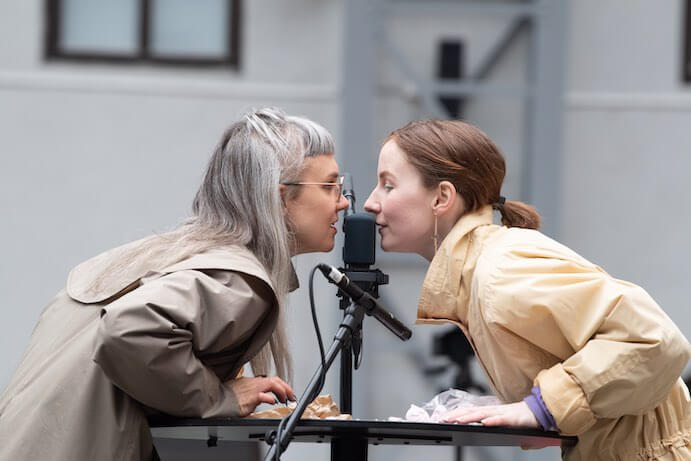“Borealis is not a transaction, but a conversation,” reflected Artistic Director Peter Meanwell after a whirlwind 25 events in 15 venues spanning March 6-10, 2019 in Bergen, Norway. In an attempt to transform one-way creative transactions into two-way dialogues between artists and audiences, conversational and communal experiences acted as the overarching concept in a year where Borealis–en festival for eksperimentell musikk had no specific guiding theme. These “conversations” unfolded literally in scheduled discussions, but also in performances that encouraged participation in various capacities, directly engaged the audience, and invited them to be part of the musical discourse.
Borealis 2019 summed up! from Borealis Festival on Vimeo.
Some performances forged physical connections with audience. In ♥︎ LOVE, a work by composer Juliana Hodkinson, The Icelandic Love Corporation, and Ensemble Adapter, we closed our eyes while performers roamed the audience, gently ringing bells in our ears amid a wash of bass clarinet, metallic percussion, harp, and flute. Throughout the performance, those who were chosen in a lottery were afforded a look behind the proverbial curtain. (I was brought to a small room with the bass clarinet where transducers were placed on my back, allowing me to feel percussive key clicks and vibrating multi-phonics in my body.)
In Carmina Escobar’s [[x]] in the flesh, Escobar produced sheets of red cellophane from her chest cavity against delicate pizzicato and tender bowed pitches from members of Liminar. After distributing the sheets to the audience, Alexander Bruck launched into a vibrant viola d’amour cadenza, accompanied by Escobar’s weightless high soprano floating over a sea of crinkling cellophane. In Phoebe Collings-James and Last Yearz Interesting Negro‘s work Sound as Weapon, Sounds 4 Survival, dancers embodied the throbbing bass that consumed the room before individually splintering out into the surrounding crowd, placing a hand on the head of a stranger, and singing them a song. Each audience-performer pair melted into an intimate moment that raised questions of non-verbal exchanges, receptivity, and consent.
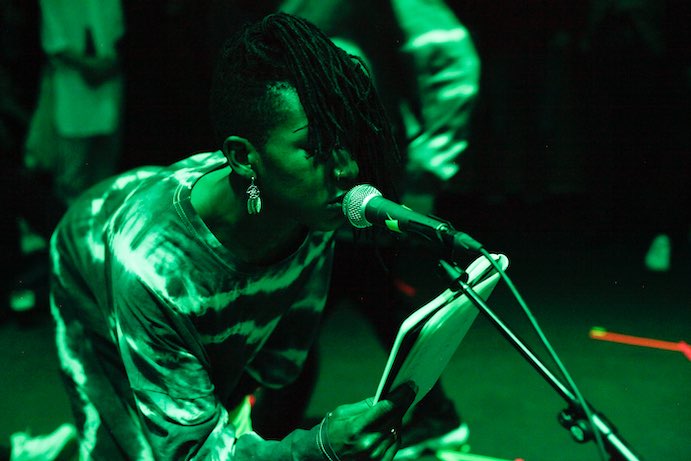
Phoebe Colling-James and Last Yearz Interesting Negro’s Sound as Weapon, Sounds 4 Survival–Photo by Johanne Karlsrud/Borealis
Other performances encouraged a two-way experience by allowing freedom of movement through non-traditional performance spaces. At the Bergen train station, Cara Tolmie and Stine Janvin captured the public’s attention with reverberant, bird-like calls that wafted to the top of the glass dome building with their visible breath. Joining together, their voices quickly hocketed back-and-forth with astonishing precision as they moved throughout the space exploring surfaces and changing acoustics before concluding with an ASMR meditation on cinnamon buns and meringues. A concert installation titled Speaker Park created a similarly immersive experience by allowing listeners to move throughout a collection of multi-channel custom-built speakers that ranged from economic to whimsical in appearance. The two compositions designed for this space by Mari Kvien Brunvoll and Antti Sakari Saario effectively combined spatialization and lo-fi charm.
By elevating audience members to active participants in an artistic dialogue, Borealis encourages people to approach performances with the mindset, “I will come to experience something,” which subverts the enjoyment-disappointment binary and opens listeners to a more complex range of reactions. As a result, Borealis 2019 not only challenged me to intently listen and critically think, but also to viscerally feel. In Beatrice Gibson’s film Deux Soeurs Qui Ne Sont Pas Soeurs, we were told that “enigmas resist interpretation,” and many of the works presented at Borealis 2019 transcended our innate desire to analyze, categorize, and contextualize and instead left me with intense emotional reactions.
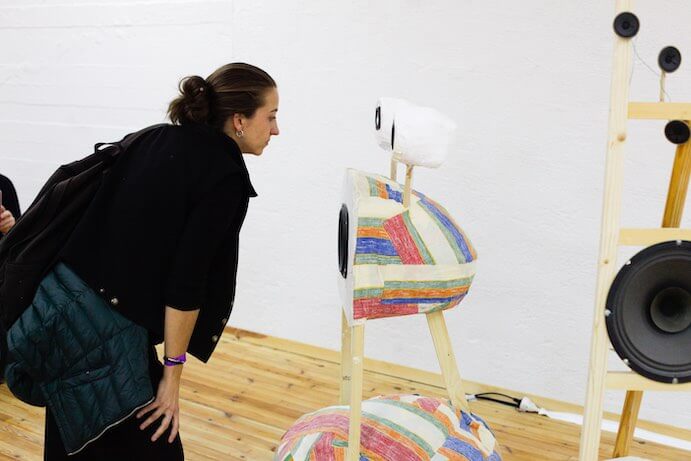
Filmmaker Manuela De Laborde interacts with an anthropomorphic lo-fi speaker at Speaker Park–Photo by Johanne Karlsrud/Borealis
Borealis made me feel riveted
On the opening evening, Diego Espinosa Cruz González delivered a mesmerizing performance of 150 pF for body capacitance (the ability of a body to store an electrical charge). Collaboratively conceived by González and Hugo Morales, the piece features quadraphonic playback of minimalist electronic pulsations triggered by rhythmic finger patterns on metal contact points. Changes in the ordering of these finger patterns were physically subtle but sonically monumental, highlighting the unique timbre of each tone. The addition of González’s tongue as a fifth contact point created wild polyrhythms that were enhanced by HD video projections.
Later that night, Norwegian composer-performer Jenny Berger Myhre and Mexican filmmaker Manuela De Laborde presented their collaboration Notas y notas y notas…, a sonic and visual collage of Mexico City. Myhre is a captivating artist with a genuine honesty and transparency to her work—zero pretense, just a humanistic approach to sharing experiences with others. Field recordings of children telling ghost stories, flashes of old family videos, ambient sounds of a marketplace, and live readings created a tender and compelling portrait that brought the first evening to a close.
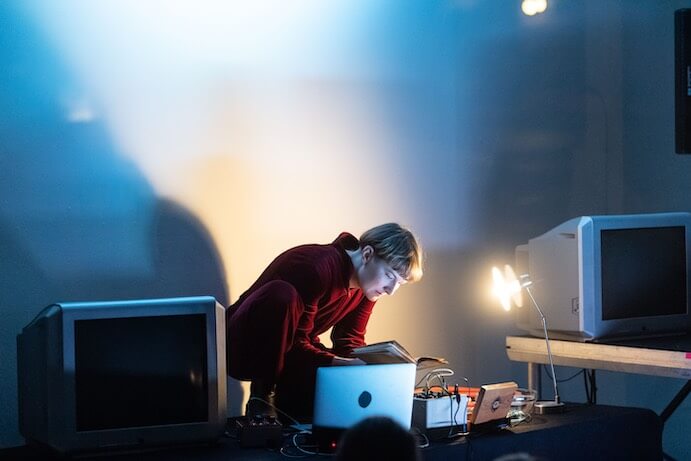
Jenny Berger Myhre and Manuela De Laborde’s Notas y notas y notas…–Photo by Thor Brødreskift/Borealis
Borealis made me feel vulnerable
London-based Canadian artist Jenny Moore was given carte blanche this year as Borealis’ first ever Artist in Residence. For three days, her project Still Life Still Loud guided people through exercises in communication, trauma release, and community-building. On day two, she tuned the room to an ensemble of vibrating bodies through Tension & Trauma Release Exercises (TRE®). Beginning the afternoon with a recording of a cosmic mermaid battle and ending with her head submerged in a bucket of water while screaming into a hydraphone, Moore invited a sense of vulnerability, especially while guiding us through the TRE®. As Moore sung to me while my body trembled, something that I have been holding onto for a long time left my body and evaporated into her voice in an intensely cathartic moment.
Borealis made me feel uneasy
With music by Matteo Fargion and text by Andrea Spreafico, We have to dress gorgeously positioned itself as an irreverent retelling of the history of music. A quirky trio of pianos tuned to A=434, 440, and 444 jangled along as Fargion and Robert M. Johanson chanted innocuous music history anecdotes: Hildegard wrote the first description of the female orgasm, John Cage and Morton Feldman threw fancy parties, none of J.S. Bach’s 20 children lived up to their father’s fame.
Despite the lighthearted opening, things became problematic when serious topics were introduced into this comedic setting. First, the two white male performers nonchalantly sang the title of Julius Eastman’s Crazy Nigger while recounting a 1980 pre-concert talk in which Eastman explained his intent to reclaim this derogatory term. My body is trained to seize with rage anytime I hear a white person utter the word, and I could write an entire essay on why Eastman’s reclaiming of this term for African Americans does not give white people license to use it freely. Things disintegrated further as the work attempted to critique Karlheinz Stockhausen’s callous remark that 9/11 was the “greatest work of art imaginable in the whole cosmos.” The quick pivots between comedy and criticism didn’t work, and the pit in my stomach solidified as people chuckled during the humorous refrain immediately following this segment. My European counterparts didn’t seem to share my experience, and I wondered how these distinctly American references would have been received by an audience in the U.S.
Borealis made me feel simultaneous existential dread and exuberant joy
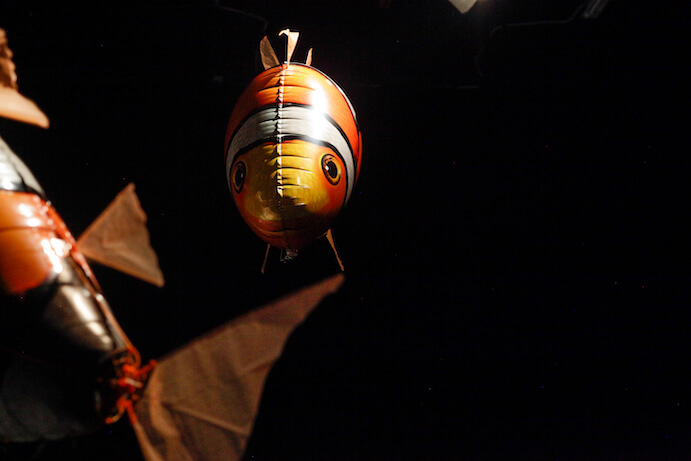
Giant clownfish fly into the audience in Jessie Marino’s Nice Guys Win Twice–Photo by Johanne Karlsrud/Borealis
Jessie Marino’s Nice Guys Win Twice takes quintessentially American images and places them in an absurd world where the things that we revere and cherish meet our deeply-rooted systemic issues. A recording of the Star Spangled Banner accompanied by finger cymbals (played with deadpan seriousness) reduced American patriotism to a muted, dull clank against proudly boasting militaristic snare drumming. Political pontificating, “shithole” countries, and “deplorables” were slashed to nonsensical babbling chaos and juxtaposed with images of American landscapes. Just as sentimental nostalgia for old TV shows threatened to consume everything, a herd of giant floating clownfish burst into the audience, cutting through the dystopian nightmare. Danish experimental ensemble SCENATET was thrilling, deftly alternating between frenetic theatrics and an explosive instrumental score.
The Norwegian premiere of Jennifer Walshe and Timothy Morton’s TIME TIME TIME also traversed the spectrum between anxiety and bliss. Primordial drones gave way to the mayhem of Walshe and M.C. Schmidt delivering a macabre up-tempo infomercial for “110% bulletproof grief”—everyone you love is going to die, so make your grief more efficient by assuming everyone is already dead! Weep silently while responding to emails! Creaking bow over-pressure and vocal fry accompanied a contemplation of dinosaur extinction before a radiant vocal duet between Walshe and Áine O’Dwyer exclaimed, “I knew I had seen the future.” Their soaring vocals rode on top of swirling trumpet and saxophone, thick double bass drones, the explosion of bang snaps, and a time-lapse video of watercolor painting, all while I held a 140 million-year-old fossil in my hand. Like the human experience of time, the moment was both glorious and fleeting.
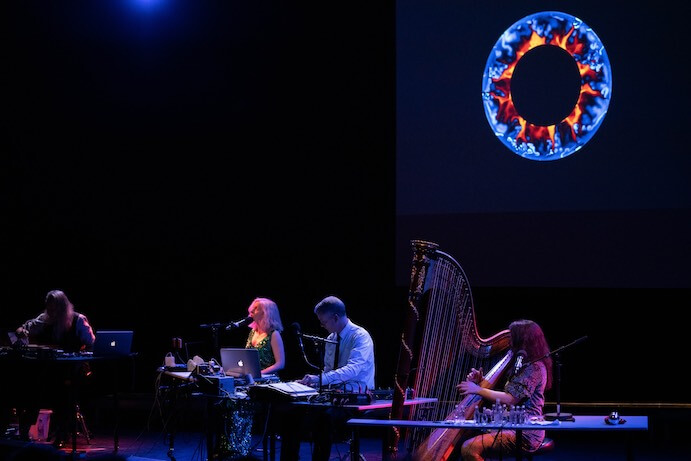
Jennifer Walshe and Timothy Morton’s TIME TIME TIME–Photo by Thor Brødreskift/Borealis
Borealis is a special festival. The 2019 edition featured panel discussions about performative allyship, articulating an ethics of listening, and making difficult music palpable, all of which were broadcast on radiOrakel, the oldest feminist radio station in the world. An international delegate program hosted 40 journalists, podcasters, curators, and performing artists from around the world. Special projects included a young composers mentoring scheme, music for fjord swimming, and a children’s performance for accessible discovery of contemporary music. Artistic Director Peter Meanwell and Managing Director Tine Rude embrace each individual iteration of Borealis and the longview simultaneously, and in viewing the festival itself as an ongoing experiment, they have created a highly-responsive and ever-evolving incubator for new ideas.


